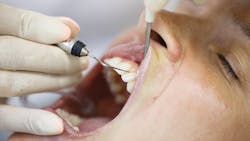Standard of care for periodontal charting
Question: What is the standard of care for new and existing patients with regard to periodontal screening and recording (PSR) versus full comprehensive periodontal charting? Also, where can I find the documentation for the standard? I have always thought that the standard is documented six-point periodontal charting, including recession, furcation, and mobility at least one time a year for existing patients and for all new patients.
I formerly worked with a periodontist who used this protocol. However, my current office says the standard of care is an annual PSR (recording codes 0–4 per each sextant) for existing patients and at the comprehensive exam for new patients. I wanted to get your thoughts before I enter into a discussion about this with my boss.
Want to read more by Dianne Watterson?
How dental hygienists can respond to negative patient remarks
The evidence on preoperative mouthwash efficacy
Answer from Dianne Watterson: This concept that we call the “standard of care” is not a solitary document. Actually, standards of care for dentistry vary from state to state. Some states have written standards; some do not. Also, standards of care are not static, meaning they change with the advent of new technologies, new materials, and new court rulings. Therefore, dentists and dental hygienists must stay up-to-date with accepted standards in their professions.
What is the standard of care? Most people think the standard of care is one of the following:
- What the average clinician does
- What the clinician was taught in dental or dental hygiene school
- What is taught in dental or dental hygiene schools now
- The best he or she can do under the circumstances
- What the majority of clinicians are doing in their practices
- What the specialist would do under the same circumstances
These ideas do not thoroughly define the standard of care. Actually, the standard of care refers more to a set of expectations, specifically that the dentist or dental hygienist will use a degree of care and skill that is expected of a reasonably competent clinician acting in the same or similar circumstances.1,2
The standard of care can best be defined in the four elements of negligence, all of which must be met to prove malpractice. Those elements are:
- a duty of care is owed by the clinician to the patient;
- the clinician violated the accepted standard of care;
- the plaintiff (patient) suffered a compensable injury; and
- the injury was proximately caused by the clinician’s substandard care.3
State boards of dentistry exist to protect the public from substandard care. They are mandated to investigate claims made by the public regarding care issues involving the standards of care of dentistry and dental hygiene.
The American Dental Hygienists’ Association (ADHA) developed a document titled “Standards for Clinical Dental Hygiene Practice” to guide the standards of care in dental hygiene. This thorough and well-written document describes periodontal probing as a standard under clinical assessment. However, it does not stipulate how often periodontal charting should be performed.4
PSR was originally developed as a way to expedite the screening process of periodontal health to indicate when a comprehensive periodontal exam is needed. As such, PSR was never intended to take the place of a comprehensive periodontal assessment. It is merely a screening protocol. When I taught in a dental hygiene program, we used PSR to determine periodontal severity level in order to help us decide if the patient should be seen by a freshman or senior student.
According to Frank DeLuca, DMD, JD, the standard of care in dentistry for periodontal charting is a full-mouth, six-point probing with all numbers recorded at a minimum of once per year for all adult patients. The reason he recommends recording all numbers is that if a jury of nondental individuals examines a periodontal chart that has only a few scattered numbers, it appears (to them) as an incomplete chart. Remember, in the eyes of the law, if it’s not recorded in the chart, it never happened.
If you ask 10 periodontists how often a patient should receive a comprehensive, six-point periodontal charting, most, if not all of them will say “once per year.” Now, if the patient has bona fide periodontitis, it would be appropriate to check specific sites during the interim visits at the most problematic areas.
J. Crystal Baxter, DDS, MDS, an expert witness who has served in 242 dental negligence cases, writes, “The fifth most common alleged negligence was failure to diagnose or treat periodontal disease in a timely fashion. There were 19 such cases, and all defendants were general dentists. In the majority of these cases, x-rays were not taken routinely, and periodontal probings were rarely or never recorded . . . To avoid suits regarding failure to diagnose periodontal disease, periodontal records are imperative. It is not necessary to do probings on a patient who only comes in for emergency treatment, but if that patient becomes a ‘regular’ patient, probings must be done and recorded routinely.”5
Once, in an office where I was consulting, I conducted a chart audit of 30 adults who had been in for preventive care in the past year. Of the 30 charts, only two had a current periodontal charting. Five patients had no periodontal charting at all. This is not unusual. The reason the hygienists were not conducting chartings is that they did not have the necessary time or help with recording. Dentists/employers should identify the barriers to charting and implement a solution so regular periodontal charting/recording is the standard in an office (i.e., once per year for all adult patients). My mantra to dental hygienists is to always have their periodontal radar engaged. They should always be looking for periodontitis.
My answer to you is that I agree with your former employer, the periodontist. PSR has utility only as a screening tool and was never meant to take the place of a comprehensive periodontal charting and recording.
What does a comprehensive periodontal exam look like?
- Full-mouth periodontal charting, including the following data points reported by location, severity, quality, written description, or numerically: probing depths, bleeding points, supperation, mucogingival relationships/defects, recession, attachment level/attachment loss
- Presence, degree, and distribution of plaque and calculus
- Gingival health/disease
- Bone height/bone loss
- Mobility and fremitus
- Presence, location, and extent of furcation involvement
Originally published in 2019 and updated regularly.
References
- Ohio standard of care for dentists. Nardone Limited. June 27, 2017. www.nardonelimited.com/dental-blog/2017/06/ohio-standard-of-care-for-dentists/.
- Blair v. Eblen. Justia. https://law.justia.com/cases/kentucky/court-of-appeals/1970/461-s-w-2d-370-1.html
- Graskemper JP. The standard of care in dentistry. J Am Dent Assoc. 2004;135(10):1449-1455.
- American Dental Hygienists’ Association. Standards for Clinical Dental Hygiene Practice. 2016. https://www.adha.org/resources-docs/2016-Revised-Standards-for-Clinical-Dental-Hygiene-Practice.pdf
- A survey of 242 dental negligence cases with a breakdown as to the sex of the defendant dentist. J Crystal Baxter, DMD, MDS.
About the Author
Dianne Glasscoe Watterson, MBA, RDH
DIANNE GLASSCOE WATTERSON, MBA, RDH, is a consultant, speaker, and author. She helps good practices become better through practical analysis and teleconsulting. Visit her website at wattersonspeaks.com. For consulting or speaking inquiries, contact Watterson at [email protected] or call (336) 472-3515.
Updated June 30, 2020

